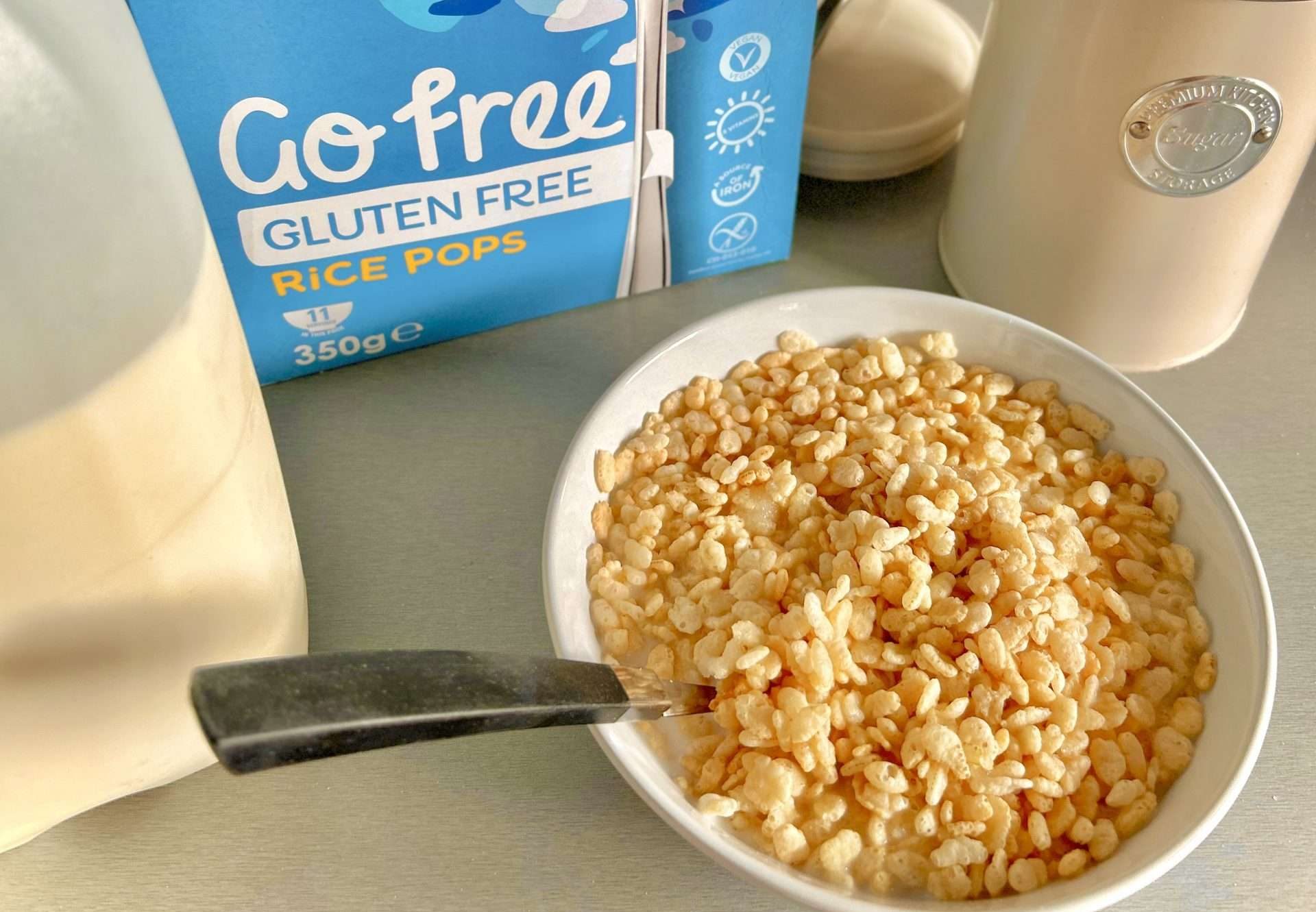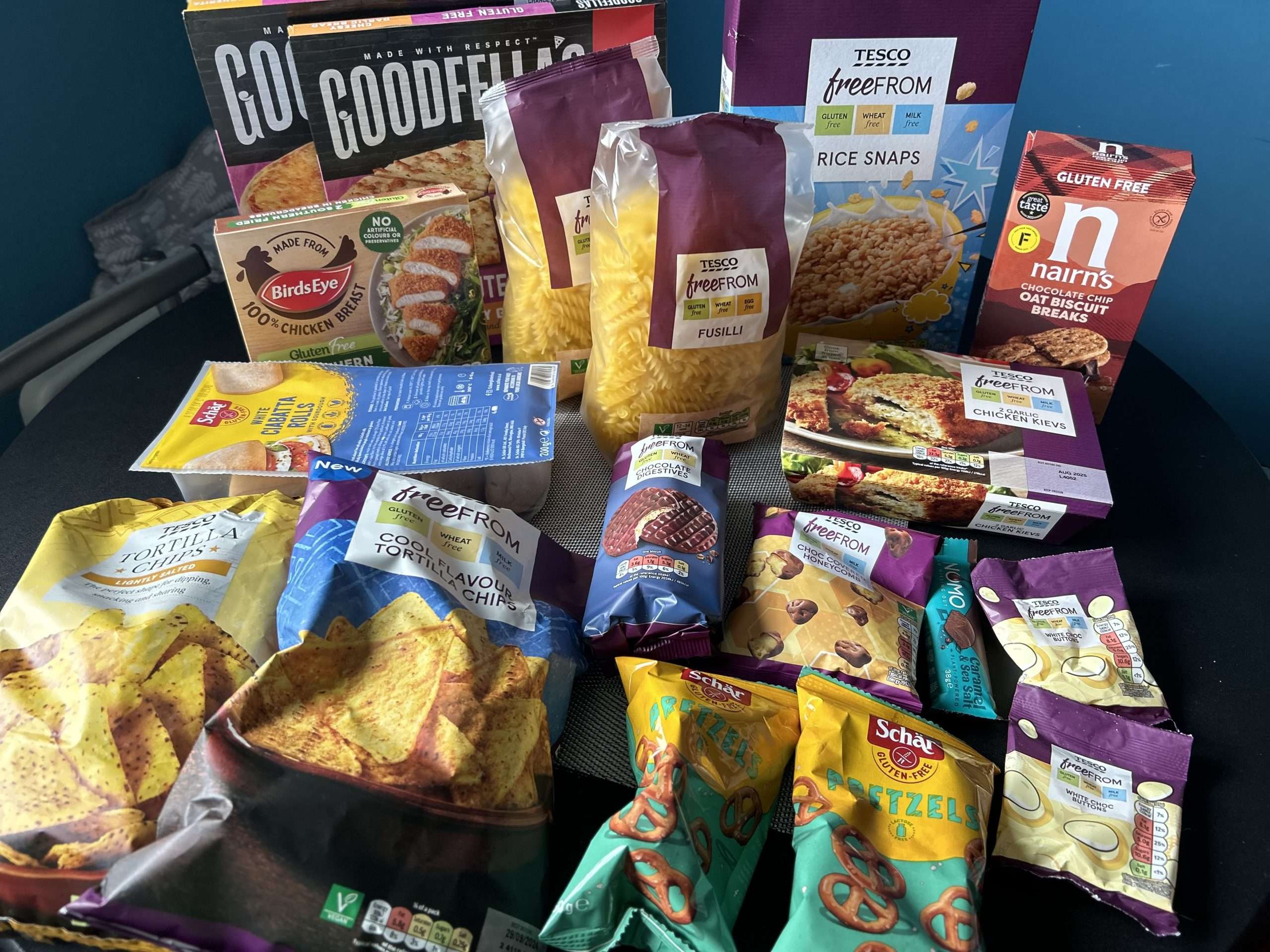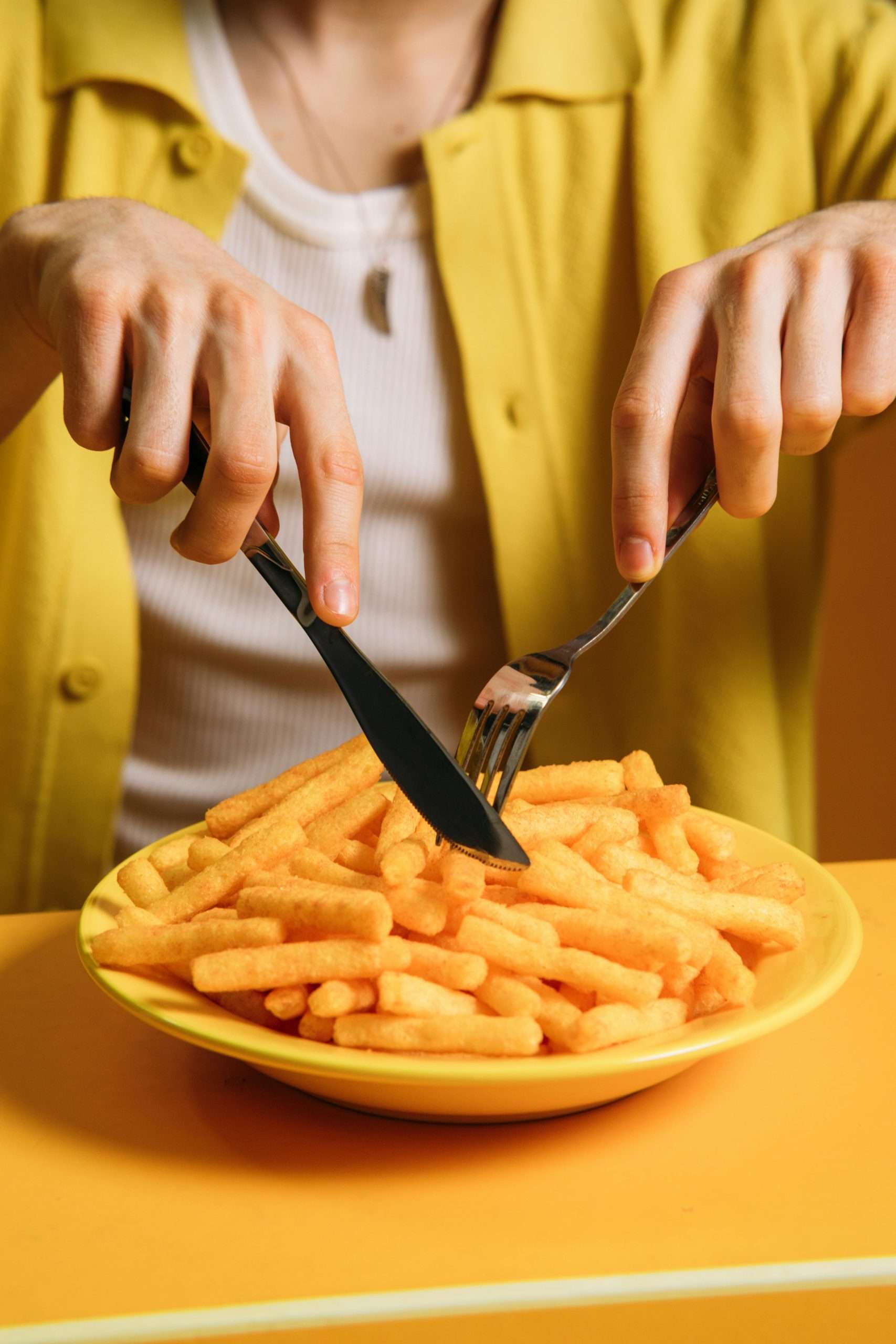When you have ARFID, a common criticism is that all our safe foods are ‘junk food’. While it’s true that for a lot of us, our safe foods consist mainly of snacks, or ‘easy’ foods, everyone is different.
Safe foods are a completely individual preference so to say that people who struggle with ARFID only eat junk food is a very broad statement that is honestly, completely incorrect. In this post I’m going to look into the idea of safe foods a little more, what they are and why they’re important. I’m also going to be addressing the question – do healthy safe foods exist?
You can find out more about what ARFID is in my post What is ARFID? Everything You Need To Know!
What are safe foods?
Suffering with ARFID means that there are a lot of things that we simply cannot eat. Then on the other side of that are the foods that we will always eat. These are known as our safe foods. Some people might only have a few safe foods while others can have a slightly bigger list, as I said earlier it’s individual to each person.
These are foods that we are comfortable around, familiar with and can rely on to be the same every time we eat them. They’re foods that don’t give us the fear and anxiety that ‘new foods’ can cause. While they can differ from person to person, some of the typical characteristics of safe foods are:
- Predictability – We know what to expect when it comes to taste and texture. So there are no fear-inducing surprises each time we go to eat it.
- Milder flavours – It can be difficult for someone with ARFID to handle a lot of flavour all at once. It can be really overwhelming so it’s common that safe foods may have a milder flavour.
- Simple recipe – Sticking to foods that are less complex when it comes to the ingredients is helpful as we are able to know exactly what is in the food we’re eating and there is less opportunity for unexpected or surprise tastes and textures.
- Familiar – Most safe foods are things that we’ve eaten for a long time. We’re familiar with them so they offer a sense of comfort as we know exactly what we can expect when we eat them.
Here’s some examples
To give a better idea of what safe foods might be for someone with ARFID, I’m going to take you through a few of my own. I have in the last six months had to make some adjustments to my safe foods due to being diagnosed with Coeliac Disease. This meant a lot of the things that were on my safe food list were now completely off limits for me. Naturally, that sent my mind into a blind panic and I figured I’d never eat again.
Luckily, there were some that I was able to keep hold of and I’ve managed to find acceptable replacements that don’t stray far from my old favourites. It’s definitely been a bit of a challenge though!
Something you’ll notice about my safe foods is that while they are in fact safe, some of them do come with conditions to that. This is typical for someone with ARFID that we may need things to be a certain brand or cooked a certain way.
Breakfast
Often I’ll not bother having breakfast (I know, I know – it’s the most important meal of the day…). When I do decide to have something, these are some of the foods I will be okay to eat 99% of the time.
- Toast with butter (no other spreads, jams, etc)
- Rice Krispies (Nestle free from brand)
- Corn flakes
- Coco Pops
- Plain porridge

Dinner
Dinner (or lunch) is a meal I tend to struggle with. There aren’t many foods on my safe list that are catered to dinner meals. Especially not ones that are easily transferable to quick, easy, already prepared meals that I can take to work with me. So some of these might seem strange for dinner options but just go with it, okay?
- Bread and butter
- Fries to go (well done)
- Plain pasta
- Chips (well done)
Honestly, that’s all I can think of off the top of my head, which seems crazy. I was really expecting there to be more on here but I’m drawing a blank. As I said above, dinner is a hard one for me and I often find myself eating the same thing everyday.
There are other things I might eat for dinner but they would typically come from some kind of fast food restaurant like McDonalds or the local sandwich shop.
Dinner is a meal that I usually supplement with snacks to make up for the lack of an actual meal.
Tea
With these ones, some might be listed as the whole meal while others are just the food. Just to keep you guys on your toes.
- Sausage pasta bake (made by me or my mum)
- Chicken garlic kievs
- Chips (well done)
- Sausages
- Plain spaghetti and meatballs
- Cheese pizza (if I can see actual tomatoes on it, usually a no go)
- Chicken nuggets/southern fried chicken breast fillets
- Cheese toasties
Snacks
Snacks are what make up about 80% of my diet. Especially since having to go gluten free. They honestly can be life savers when I’m struggling to find something I like or if I don’t have any interest in making a meal that day. There might seem like there isn’t in fact a lot on here but that’s because I tend to stick to certain foods over and over again – that is until ARFID randomly decides we don’t like it anymore!
- Plain tortilla chips (used to be Doritos before my CD diagnosis)
- Chocolate digestive biscuits
- Schars salted pretzels
- Chocolate covered rice cakes
- Co-ops chocolate chip cookies
- Aero mint chocolate bar
- Cream crackers
- Chips (I know this is on other lists but honestly, I could eat chips any time, any where. They make up like one of my main food groups)
- Seabrooks ready salted crisps (or they might be called sea salted or something like that?)

Obviously this is not an exhaustive list. I’m sure there are other foods that should be on here that I’ve forgotten! But I feel like this is a good outline.
As you can see, a lot of these foods are quite plain and basic. And yes, I’m aware that a lot of my own safe foods aren’t exactly the healthiest. But does that mean healthy safe foods don’t exist?
The problem with typically healthy foods
When it comes to typical healthy foods, I’m mainly talking about things like fruits and vegetables. These kinds of foods can cause a few issues for people that have ARFID. They can be unpredictable in terms of their taste, texture and appearance which can be cause for anxiety.
For example, I like apples but I wouldn’t consider them a safe food. Why? Well because you never quite know what you’re going to get.
You might have an apple one day and it’s crunchy and sweet and pretty nice! Then the next day you might go to get another one. But this one is a little soft and a little sour and you don’t really enjoy it. Plus, the first apple? It was a lovely red colour most of the way around. The next apple was half red and half greeny yellow. What’s that about?
The inconsistency of the apple makes it hard for me to accept it instantly as a safe food. I have to approach each apple individually to decide whether it’s something I’ll be able to eat or not.
This can be the case for most fruits. The taste, texture and appearance of fruit can differ depending on the type of fruit, the time of year and a whole load of other things which just makes them too unpredictable for a lot of people with ARFID.
Vegetables are an issue for the same problem. Just too inconsistent! I also find that with vegetables it can matter a lot as to how they’re prepared.
Take potatoes for example. In the words of Samwise Gamgee, you can “boil ‘em, mash ‘em, stick ‘em in a stew”.
As I mentioned earlier, chips are my absolute go to no matter where I am or what I’m doing. Despite that, you will never find me asking for a jacket potato, or a plate of bangers and mash or some new potatoes.
The difference in textures and tastes can be a big problem. Especially for someone that deals with Avoidant ARFID where the sensory aspects play a large part in their anxiety towards food.
When it comes to healthy meals, they tend to contain a much larger range of ingredients. Meals such as a stir-fry, salads and mixed dishes for example. The many different tastes, textures, smells and appearances can be super overwhelming for those of us with ARFID. For this reason, we tend to shy away from these ‘healthy’ options and stick with what we know.
Do healthy safe foods exist?
While it’s common that people with ARFID may have safe foods that are more simple or processed, that doesn’t mean there is no such thing as healthy safe foods.
There are plenty of people out there that struggle with ARFID but their favourite foods are things like apple slices, carrot sticks, quinoa. Safe foods are considered ‘safe’ on an individual basis so what works for one person, might be a complete no go for someone else.
By tarring everyone that has ARFID with the same brush, it can be really damaging for the cause as a whole. It’s important we recognised the individuality of ARFID because it really is a disorder that is not one size fits all!
If you want to know more about how we can fight the criticisms of ARFID, why not take a look at this post – ‘How to Deal With ARFID Negativity‘
The other question we have to ask is what exactly do we mean by healthy? Are we talking about foods that have the most nutrition and vitamins? Are we talking strictly about fruit and veg (like I’ve used in my examples above)? Or do we mean healthy in the sense that those struggling are getting what they need to survive?
If we look at the last question, then by all accounts any kind of safe food is a healthy food. A big part of having ARFID is that if we don’t have any of those safe foods available to us or we’re only presented with foods that we’re unable to eat, we will choose to simply not eat.

I don’t think I’m crazy in saying that someone being able to eat their bowl of chips is going to be a lot more healthy for them than not eating anything at all?
Obviously one of the key aspects of having ARFID is that we are likely to lack some of the vitamins and nutrients that our bodies need. This can cause issues with growth and malnutrition. We absolutely have to take this into account and it’s important that those who do struggle with those are being monitored and taken care of by a healthcare professional. This is why you’ll find a lot of people with ARFID require supplements to their diet.
That being said, in my opinion when it comes to ARFID it’s always good to remember that fed is best. We may not be eating what society wants us to but we are eating and that is what’s important.
While we are able to eat our safe foods, we can work our way up from there to bring more food into our diet. We can try new things at our own pace and who knows? Eventually we might be able to eat a salad or a healthy balanced meal?
I recently did a food exposure in Episode 2 of my video series ‘CC’s Coeliac Taste Tests’ – if you haven’t yet, you can click on the link to give it a watch! I tried a chicken gryo’s wrap for the first time in my life. It had pitta bread, chicken and iceberg lettuce. It didn’t make it to my safe list BUT I did eat a large portion of it and it was something I could see myself eating again. That’s probably one of the healthiest things I’ve eaten in a long time and I was really proud of myself for trying it.
Safe is what makes you feel safe
Just because the typical ‘healthy foods’ are not on our safe lists, it doesn’t mean we’re not eating healthy. When you have ARFID you have to eat what makes you feel comfortable. If you’re taking a salad into work for dinner? That’s great because you’re eating. If that means you’re living off snacks? That’s great because you’re eating. The rest can be worked on at a pace that works for you and your eating disorder.
For someone with ARFID, safe foods are vitally important no matter what they are. So despite what other people are saying about it, it’s none of their damn business. You have to do what’s best for you.
And for those that are nitpicky – yes, healthy safe foods do exist, both through fruit and veg and vitamins and also through the simple, comfortable foods that just get us through the day.
If you have ARFID and have ever been called out for your safe foods, leave a comment below! I’m sure I can’t be the only one. Make sure to share this post so we can help educate others and give a better understanding of what life can be like when you have ARFID!
If you’re someone that knows someone with ARFID, do you know their safe foods? Knowing someone’s safe foods can be a great way to show your support and let them know that they’re safe eating around you!
Check out other ways you can support someone with ARFID in this post – 7 Helpful Ways to Support Someone With ARFID






AFRID only seems to exist in high-income countries like the US and similar. I highly doubt you’d encounter this in say, Africa, most of Asia, lower-income countries, etc. “Safe” AFRID food lists are often lists of fast foods and junk food – foods that are high in sugar, salt, fat, carbs, or all of the above. Folks say their safe foods are consistent in taste and texture, while fruits and veggies are not. I don’t accept this as true; a raw carrot always tastes about the same, it’s just not full of sugar, salt, and fat. A banana that’s of a certain ripeness always tastes the same. A green apple always has the same texture and taste. Blueberries vary a bit in taste and texture, sure, but it’s the sour ones that mostly bother people (i.e. lack of sugar, as we’re conditioned to crave sugar in our society…) Meanwhile, fries from McDonalds can vary just as much as say, lettuce. They can be more crisp, soggy, cold, warm, have more or less salt depending on who is cooking them, etc. The idea that fast food is always exactly the same in taste and texture simply isn’t true. It’s just full of salt, sugar, fat, and carbs, and that’s what you’ve come to crave, most likely b/c that’s what your parents raised you on. I accept that a very limited number of people out there have true anxiety about food textures and smells, but I think they’re in the vast minority of people claiming to have AFRID, a relatively new concept. Really, our culture is one that is full of fast, over-processed, unhealthy foods that kids have been raised on such that their palette and tastes never expanded beyond childhood. I sincerely believe AFRID was created as a diagnosis to validate childhood behaviors persisting into adulthood; which is fine temporarily if it leads people to start eating a much wider variety of foods, including healthy foods not high in fat/salt/sugar/carbs. But if it simply validates adults continuing with bad eating habits from their youth and acceptance of this as being ok, I think that’s a problem. Adults need mostly foods that aren’t super high in salt and sugar, with modest amounts of healthy fats and carbs. And those with AFRID having kids will have kids that continue with this cycle of limiting their diets to foods high in salt/sugar/fat/carbs. That cycle needs to be broken, not condoned.
Hi Em,
Thanks for taking the time to read the article! While I hear what you’re saying, I have to respectfully disagree. As I mentioned in the post, there are a number of people that have ARFID whose safe foods do consist of foods like fruit and vegetables and what is traditionally considered ‘healthy’ foods. There are people that suffer from ARFID and might not want to step foot in a fast food restaurant. So the idea that people with ARFID are simply craving sugary, salty or fatty foods is just simply not true. It varies from person to person.
In regards to the point you make about textures and tastes not always being consistent with fast food versus other foods, again this is an entirely preferential thing. There is no one size fits all with ARFID. Some people might find their consistency in those raw carrots you mentioned. I know for me personally, when we would be given them during break time at school I found them to be different every time. Aside from that, not everyone with ARFID struggles with the sensory side of it. For some people it comes from a fear of vomiting, becoming ill or other traumas that might occur. For some it’s simply a case of not receiving the same hunger cues people without ARFID get. It’s not always determined by the taste, look, smell, etc.
I’d also like to add that ARFID is in fact present in many third world populations however it’s severely under reported due to lack of medical knowledge and medical accessibility.
Finally, I can with quite certainty say that my ARFID is not due to being raised eating sugary, salty, or fatty foods. My parents made sure that myself and my sibling ate healthy varied meals – even if it meant I sat at the table not eating anything, it was still what I was presented with. It was only when I started showing signs of malnutrition that my parents had to allow me to eat my safe foods in order for me to stay alive. Furthermore, I find your comment about those with ARFID ‘continuing the cycle’ to be rather offensive. I know many people that have ARFID that are actively trying their best to provide their children with varied and healthy meals. Nobody with ARFID wants anyone else to have to suffer with it and if I was to have children I know that I would make sure they ate a balanced diet, regardless of my own eating disorder.
If you want to learn more about Avoidant Restrictive Food Intake Disorder, I have a whole section of it here on the blog so feel free to take a look and expand your knowledge on the eating disorder. I’d recommend starting with ‘What is ARFID? Everything You Need To Know‘
Feel free to get in touch if you have any questions!